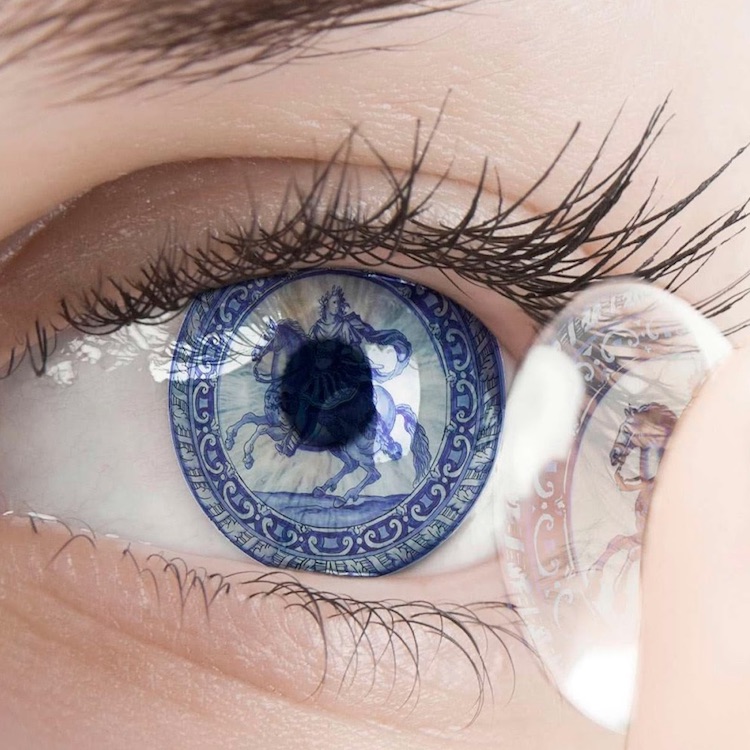AMSTERDAM — The Rijksmuseum has announced the Top 10 entries for its 2017 Rijksstudio Award. The museum’s international panel of experts selected the ten best designs from more than 2,000 entries — ranging from ceramics to condoms, all were inspired by the Rijksmuseum collection.
The competition was open to the public and all art disciplines. Again, the only rule: The work had to be based on a piece from the Rijksmuseum collection and includes images from Rijksstudio. Rilkstudio is a free graphic service allowing users to use images from the museum’s collection to discover, collect, share, touch, ‘like’ and (here’s the cool part) edit.
Excitingly scouring the selections, we spotted a few contemporary ceramic interpretations and ceramic-inspired submissions that caught our eye, including these neat Delft contact lenses.
A top 10 finalist, Francine LeClerq and Ali Soltani’s Delft Blue Eyes are a nod to Marcel Duchamp’s comments on the ocular pandering of “retinal art.”
While drawing on a distinct cultural heritage of Dutch Delftware, the direct juxtaposition of a perceived work and its viewing subject is a nod to Marcel Duschamp’s critic on retinal art through the selective process of “Readymades.” Today, in an era enmeshed by trajectories of prying eyes, the perceiving subject itself is the tentative Readymade the moment it is caught viewing it’s prey, here the enameled tin-glaze of delft under a glassy gaze.
Delft Blue Eyes are non-prescriptive cosmetic lenses whose hydrogel surface has been painted or printed with a Delft pattern inspired by these plaques from the museum’s collection.

De Grieksche A, Two plaques from a column, c. 1690 tile, 49 × 25 × 2 inches
Up next, we were stunned by this delightful butter dish by Israeli artist Rina Elman.
The butter dish was inspired by this gorgeous dress worn by Helena Slicher, wife of Aelbrecht baron van Slingelandt, on her wedding day in 1759, the Rijksmuseum writes.
Slicher wore this gown with a skirt no less than two-metres wide! The skirt is supported by large panniers, side hoops around the hips. Unusually, this dress combines two different types of court dress. The bodice with a ‘tail’ follows the English court dress, a mantua, while the loose train was popular primarily on the Continent.
To view other designs from finalists, though not featured above, visit Rijksstudios.
The public is also invited to vote for their favorite pick from the Top 10 list. The winner of the Public Award will be announced during the Rijksstudio Award presentation on 21 April.
The following ceramic picks are from the museums’ Top 30 list.

Small Museum Pieces by Jeroen de Cooman. Click for larger image
This sweet floral and gold ice cream scoop and dish set by Belgian artis Jeroen de Cooman were inspired by the museum’s porcelain serviceware collection.

Porcelainfabriek awn den Amstel, Porcelain sauceboats, cream pots and plate. c 1974 – c. 1809. Hard-paste porcelain, 10 inches. Click for larger image
Man your battle stations as we highlight Soup Battles by Polish designer Kasia Zareba. The work playfully employs the The Battle of Terheide by Willam van de Velde in circumference of a soupy battle scene.
From the museum:
To commemorate the Dutch naval commander Maerten Harpertsz Tromp, his family commissioned a series of pen paintings of Tromp’s best-known battles from Willem van de Velde. The artist used pen and ink on canvas for these works, which resemble meticulous, accurate engravings. Van de Velde witnessed the Battle of Terheide in 1653. He used the sketches that he produced on board as studies for this pen painting.

Soup Battles by Kasia Zareba

Willem van de Velde (I), The Battle of Terheide, 1657, canvas, 67 × 113 inches. Click for larger image
Similarly designed, Iwona Lisiecka‘s Land of Water drew inspiration from a black chalk drawing by George Hendrik Breitner.

George Hendrik Breitner, Gezicht op een straat in Amsterdam, c. 1903, Black chalk. Click for larger image
The ombre effect of Diluted China by Eloïse Maës draws it’s volume and palette from a powder blue vase featuring a Chinese woman in a garden.

Diluted China by Eloïse Maës

Anonymous, Cylindrical vase with powder blue and two panels with a Chinese ladies in a fenced garden, c. 1700 – c. 1724, Porcelain, 10 × 4 1/2 inches
The first prize for the award is 10,000 euro, second is 2,500 euro, and the third is 1,500 euro (approximately $10,600, $2,600 and $1,600 respectively). Additionally, the Public Award winner will receive 1,000 euro (approx. $1060).
Do you love or loathe these works from the worlds of contemporary ceramic art and contemporary ceramics? Let us know in the comments.






Add your valued opinion to this post.